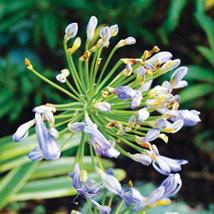AGAPANTHUS hail from South Africa, and I’ve so many in the borders at Buckland Castle that I’m worried – not that they’ll take over like a herd of hungry springbok, but that they’ll fall prey to a bizarre 2-3mm-long grub that bores into the buds and ruins the flowers. I say bizarre, because the grubs and the flying midge that lay them have never been recorded outside of UK gardens. As such, they are a new species to science.

The discovery of any organism is exciting as it makes the world seem big. However, agapanthus gall midge has somehow arrived on our shores (presumably from South Africa), but without the insects, birds and bacteria that kept its numbers so small, it was a secret – until now.
Since its discovery here in 2014, and unbounded by predators, agapanthus gall midge has spread across the south of the UK, so its arrival on my agapanthus (and yours) isn’t a matter of ‘if’ but ‘when’.
However, all is not lost. Vigilance and fast pruning are key, and should deformed flower buds and brown discolouration on the petals appear, it’s important to act fast and snip off affected blooms before the grubs that cause the damage have time to reach maturity.

If plants are in pots, dig them up in the dormant season and wash off the roots before repotting in fresh compost. This rids the roots of grubs that have gone to ground to pupate and sit out the winter.
For agapanthus in the ground like mine, there’s another trick to keep up your sleeve. Apply a ‘pot topper’ around plants you suspect might be affected. Toppers are fragrant mulches that disorientate, delay or kill unwanted insect pests with natural oils (see below). They might not eradicate the larvae, but they’ll reduce numbers by making the shallow roots of the agapanthus harder to find and, fingers crossed, they’ll buy time until our native birds and beetles get a taste for the grubs.

How to deter agapanthus gall midge
POT toppers are a new way of dealing with pests that echoes how plants look after themselves in the wild. Leaf litter, especially from fragrant herbs like rosemary, lavender and eucalyptus, is packed with scented oil that acts as a natural pest stopper. You could grow and collect your own (I’m experimenting with eucalyptus leaves now) or use a product such as Z-Total (made from olive stones and rosemary) or for larger areas the Royal Horticultural Society has found that finely chipped bark (Melcourt EcoBark) or Strulch (composted straw) works to reduce gall midge numbers or delay their emergence until after flowers have finished.
Toby’s trivia

1 Galls are distortions in plant growth, made by insect larvae that inject dividing cells changing their shape into pockets in which the insects develop. Seen here are galls on broom (Cytisus scoparius).

2 A sure sign of agapanthus gall midge infestation are creamy yellow, 2-3mm maggots inside the distorted buds. Council composting will kill them so it’s fine to put affected flowers in the green bin.